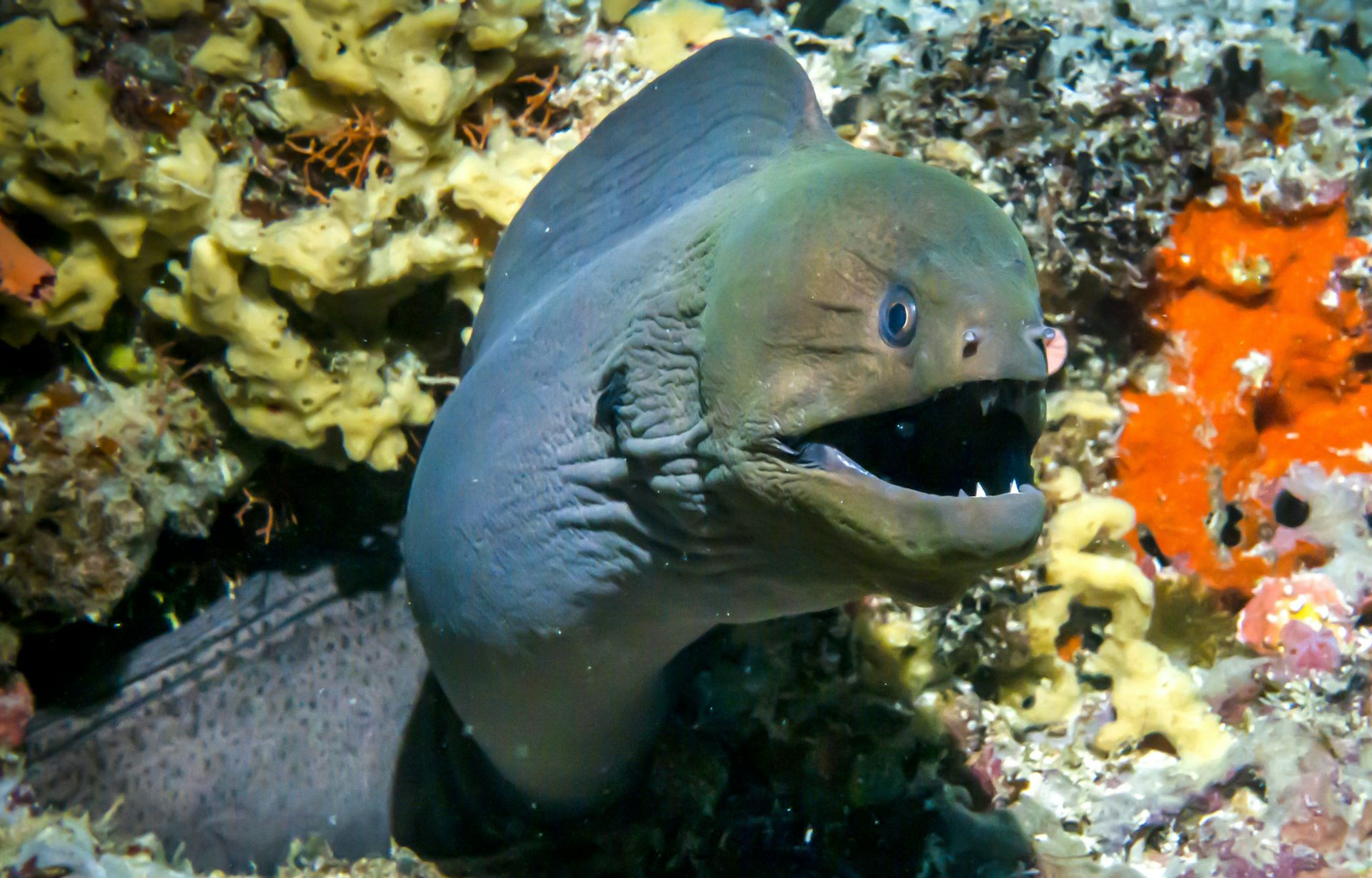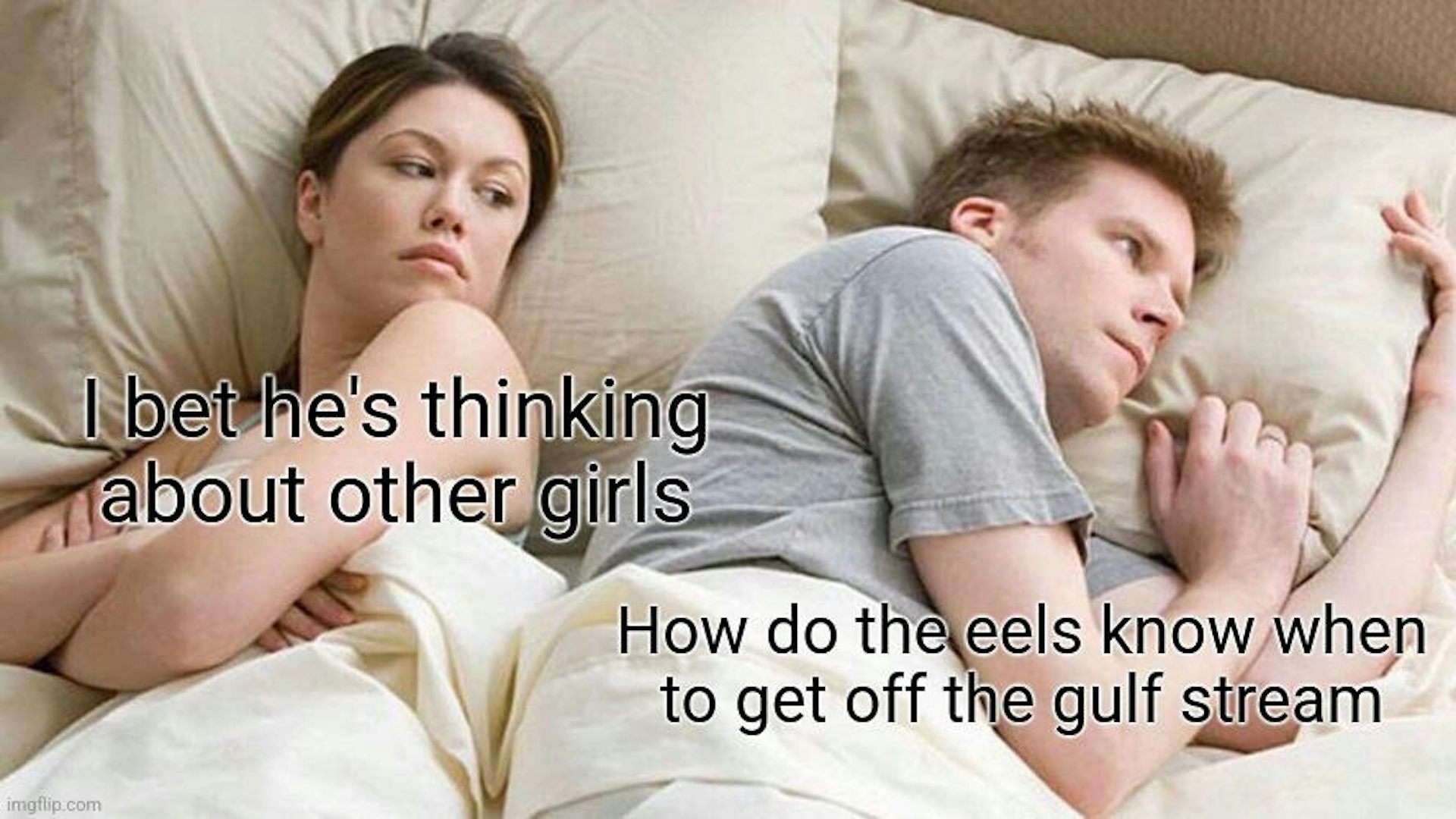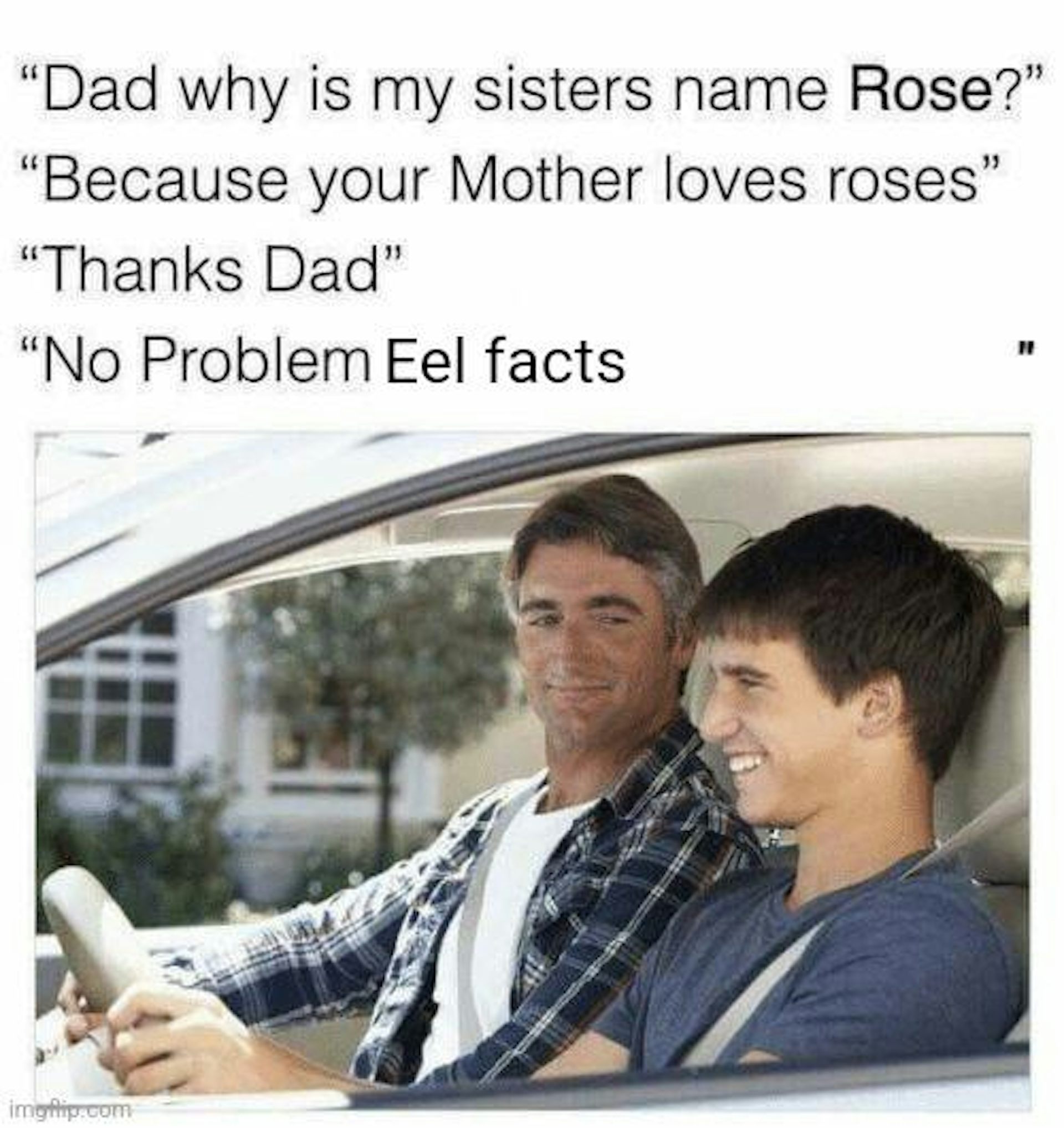Now for Dr. Soanes' article, reprinted here under a Creative Commons license, reformatted for stylistic consistency. The original article can be read here:How The Eel Was Designed
The European Eel (Anguilla anguilla) is a wonderful example of howGod, sorry, the Intelligent Designer works.
One day the Intelligent Designer decided to make a strange creature that looked like a snake, but which lived in water like a fish. He used gills like he had used for other fish so they could breathe in water and which He had decided not to use for some other animals which live in water, like seals, whales and turtles and He decided to include some small scales on their skin which don't seem to have any purpose because he designed them with a tough, slimy skin, but obviously these scales weren't there by accident.
But His most brilliant idea was how they were going to breed. He made it so they needed to spend many years living in rivers and lakes and places like paddy fields and even sewers to put on enough weight so they could go on a very long journey across the Atlantic all the way to the Sargasso Sea near America to lay their eggs, so the young eels have to travel all the way back to Europe again. This is obviously much more sensible than just laying their eggs in the rivers where they live, like most other fish do.
To make this journey, He designed eels so that, come the time for breeding, they strip their bodies down to the bare essentials - basically just the equipment for swimming, a large store of fat for the journey and a pair of gonads for reproducing. They have to take up to fifteen years getting fat enough before they do the journey and then they digest their own digestive system to make themselves lighter. This is obviously much better than needing to bother with eating on the journey through an ocean teeming with the sort of food they had been eating in the rivers they grew up in. As any experienced back-packer will tell you, it's obviously much better to be really big and fat before you start a long journey to save you having to bother eating on the way, and then doing away with your digestive system to make you lighter.
In fact, He brilliantly designed them to look like you would expect if they had once been sea-living at a time when their spawning ground was much closer to Europe but now someone had moved it all the way to America as though they were moving the sea bed around. The fact that very many of them don't survive the journey to the Sargasso Sea is all part of the plan obviously because this ensures that only those best at swimming to the Sargasso Sea get rewarded with breeding - and you can't say fairer than that.
He also made sure that they have no hope of ever returning once they've spawned because they can't eat and have used up all their fat, and He had another brilliant plan for them to go to all this trouble so most of their offspring would be eaten by other things on their journey back to Europe just as though their real purpose was to be food for other creatures.
Then, in a brilliant final move, the Intelligent Designer had the brilliant idea of designing a parasitic nematode worm which used to live only in a Japanese relative of the European eel but which He has now changed slightly so it now infects 80-100% of European eels, making it difficult for them to use the swim-bladders he had given them to make swimming easier, so the European eel is now an endangered species, as the number of young reaching Europe from the Sargasso Sea is down to a mere 2% of its former numbers in some places. But then who wants a lot of those ghastly slimy eels around, eh?
You have to hand it toGodthe Intelligent designer when He can come up with designs like that, don't you. Obviously, nothing like that could be produced by a mindless, natural, undirected, purposeless process like that silly Charles Darwin invented.

Eels are some of nature’s weirdest creatures. Here are 5 reasons why they’re such cool little freaks

A moray eel.
Credit: Shutterstock
Aristotle’s best guess was that they spontaneously generated. Danish biologist Johannes Schmidt was pretty sure they spawned in the Sargasso Sea – right near the Bermuda Triangle, for a little extra mystery. His extensive biological surveys over 100 years ago found lots of young eels in this area, leading him to conclude they must hatch somewhere nearby.
But eggs or adult eels breeding were never seen anywhere nearby. So the question remained unanswered … until now.
Last week, a team of researchers were able to confirm that yes, the 1-metre long European eel people knew from their local river really did come from a sub-tropical sea up to 10,000 kilometres away. This team had something history’s biggest thinkers didn’t: cool tech.
Pop-up Satellite Archival Tags are a relatively new type of tracking device that allows scientists to map the movements of marine creatures in a way that simply wasn’t possible before. The tags record where the animals travel, how fast they move, and even how deep they dive. Then, the tags detach and float to the surface where they can transmit data back into the hands of eager scientists.
ALL the eels in Europe and America are born in the Sargasso Sea (in the Bermuda Triangle! Ominous? Yes).
— Eelmily Finch (@DrEmilyFinch) October 18, 2022
Eels might even live in a landlocked part of Europe and yet they will travel thousands of kilometres over land (yes, land!) and sea to get to the Sargasso Sea to spawn.
2/?
Australia, too, has its own illustrious eels. They generally keep to themselves, so much so that most of us wouldn’t even know they’re there. But with all this rain and flooding, there’s a chance you might stumble across one soon.
So I thought this was a good time to share five things you might not know about eels, including in Australia.
1. We have our own marvellous migration story in Australia
While not quite as long as the European eel’s journey, Australia’s short-finned eels undertake a massive migration.
In research published last year, researchers from the Arthur Rylah Institute and Gunditj Mirring Traditional Owner Aboriginal Corporation used satellite tracking tags to map the path of 16 eels from Port Phillip Bay off Melbourne, to the Coral Sea outside the Great Barrier Reef. Some travelled almost 3000km in just five months.
It’s an arduous journey. The tags showed some eels dive to depths of almost 1,000m below the ocean surface, taking advantage of currents and dodging predators. Not all were successful though - at least five of the tracked eels were eaten by sharks or whales.
2. Eels are obstacle course masters
When you stop to think about it, there are more than a few obstacles between inland fresh waters and the ocean. Many of the swamps and wetlands that would traditionally have offered safe passage have been filled in, replaced by farms, dams and cities.
And yet, eels find a way. One key feature is their ability to breathe through their skin, meaning even the shallowest drain or puddle-soaked lawn is enough water for them to move through.
According to urban legends, eels have been seen slithering through urban gutters, sports ovals, or over university campus fountains, following ancient pathways back out to sea.
ONLY IN QUEENSLAND: This woman found an Eel in a Logan street- gave it a kiss- and let it go!! @9NewsQueensland @9NewsAUS pic.twitter.com/xu8Dwg2Xoa
— Peter Fegan (@PeterFegan9) March 2, 2022
Imagine if you had to go through puberty four or five times, with each bodily change more dramatic than the last. Then you’d have a pretty good understanding of what it’s like to be an eel.
Migrating eels have to go from being a saltwater fish to a freshwater fish and back again, which means they have incredible life cycles. They start out as as tiny larva out in the ocean in the Sargasso or Coral Sea where they spawn, before morphing into translucent “glass eels”.
After that, they shape-shift into darker “elvers” at about one year old as they make their way back to fresh water, where they eventually mature into the adult eels that live in our rives, lakes and dams.
When the time comes, they make their final transformation into lean, mean, migrating machines – known as silver eels.
Their eyes grow larger and their heads becomes pointed and streamlined. They also stop eating, as their stomachs shrink to make way for bigger gonads (all the better to spawn with).
Also, did you know that baby eels are transparent and look a lot like like vermicelli?
— Eelmily Finch (@DrEmilyFinch) October 18, 2022
10/? pic.twitter.com/Ol9x80hvEd
Speaking of gonads, Sigmund Freud (yes, that Freud) spent the early years of his research career trying to understand the sexual anatomy of eels.
Unfortunately for Freud, and the eels, the only way to tell if an eel is male or female is to dissect it to observe it’s internal reproductive organs.
Despite performing hundreds of dissections, Freud rarely found male eels. Turns out, this is because eels don’t develop reproductive parts until later in life – usually not until they’re at least ten years old.
5) Eels can live very long lives
Yes, these long fish have long lives, with some eels living to be more than 50 years old.
One man in Sweden claimed his backyard eel lived to 155, while another eel reportedly lived to 85 in a Swedish Aquarium.
Eels spend the first few years of life getting from their spawning grounds back to fresh water, and the last few making the return journey out to sea. They only make this spawning once – after that, they die.
Why is this kind of research important?
There’s still so much we don’t understand about eels around the world. But satellite research such as that published this week, takes us a step closer to pulling all the pieces together.
This has real implications for how we look after eel populations. The European eel (Anguilla anguilla) is critically endangered, with the species experiencing declines of up to 95% in the last 50 years.
We don’t really know how well Australian eels are tracking. If we understand where animals breed and how they get there, it means we can find ways to help, rather than hinder their journey, and protect the places that are important.
The Conversation is grateful for the contribution of Australia’s number 1 eel enthusiast, Dr Emily Finch, whose twitter thread inspired this article
Kylie Soanes, Postdoctoral Fellow, School of Ecosystem and Forest Sciences, The University of Melbourne
AbstractEverything I hinted at in my original 2013 article about no intelligence involved in the design of the European eel has been borne out by this research and the ludicrously long trip to their then hypothecated spawning ground in the Sargasso Sea has now been established as a fact.
The European eel (Anguilla anguilla) is critically endangered (according to the most recent IUCN assessment) and has suffered a 95% decline in recruitment since the 1980s, attributed in part to factors occurring during the marine phases of its life-cycle. As an adult, the European eel undertakes the longest spawning migration of all anguillid eels, a distance of 5000 to 10,000 km across the Atlantic Ocean to the Sargasso Sea. However, despite the passage of almost 100 years since Johannes Schmidt proposed the Sargasso Sea as the breeding place of European eels on the basis of larval surveys, no eggs or spawning adults have ever been sampled there to confirm this. Fundamental questions therefore remain about the oceanic migration of adult eels, including navigation mechanisms, the routes taken, timings of arrival, swimming speed and spawning locations. We attached satellite tags to 26 eels from rivers in the Azores archipelago and tracked them for periods between 40 and 366 days at speeds between 3 and 12 km day−1, and provide the first direct evidence of adult European eels reaching their presumed breeding place in the Sargasso Sea.
Wright, R.M., Piper, A.T., Aarestrup, K. et al.
First direct evidence of adult European eels migrating to their breeding place in the Sargasso Sea.
Sci Rep 12, 15362 (2022). DOI: 10.1038/s41598-022-19248-8
Copyright: © 2022 The authors. Published by Springer Nature Ltd. Open access
Reprinted under a Creative Commons Attribution 4.0 International license (CC BY 4.0)
This, as you would expect unless you're a brainwashed Creationist, is all fully understandable as an evolutionary response to tectonic moving of the spawning grounds which were once much closer to Europe. Nothing which could be called intelligent would design a method of breeding that was so massively wasteful and included the loss of a high percentage of offspring due to predation and the journey back to Europe, after such an effort to prepare the adult eels for breeding over very many years. That creationists would even consider this the work of a divine super-intelligence probably helps explain why they find evolution too hard to understand.





No comments :
Post a Comment
Obscene, threatening or obnoxious messages, preaching, abuse and spam will be removed, as will anything by known Internet trolls and stalkers, by known sock-puppet accounts and anything not connected with the post,
A claim made without evidence can be dismissed without evidence. Remember: your opinion is not an established fact unless corroborated.